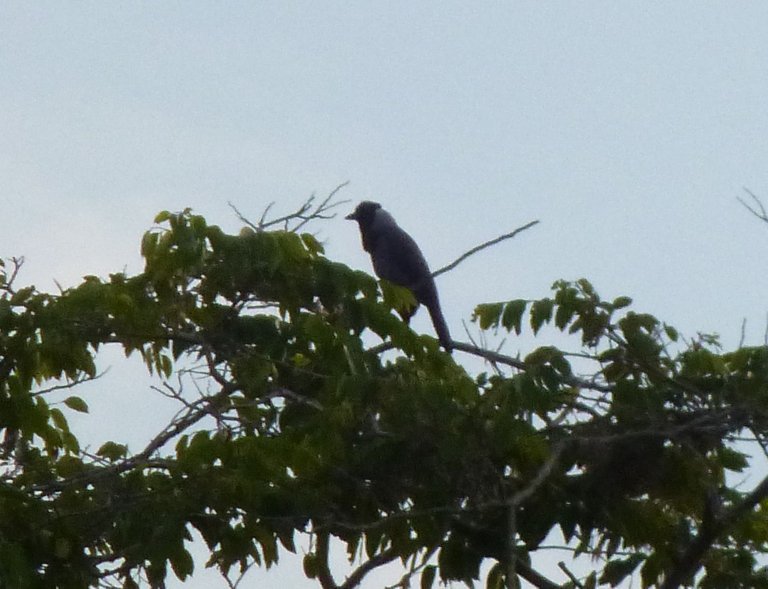Eliot Miller, Cornell Lab of Ornithology post-doctoral associate, used data from Project FeederWatch to spearhead an anlaysis of the pecking order at North American bird feeders.
Image Source Cornell Lab of Ornithology

Pecking Order
You may remember my post of the feeding frenzy these European Starlings caused at my bird feeder.
Original Video from Earlier Post

It has been my unscientific observation that the Red-bellied Woodpecker rules over the feeder at least until a feeding frenzy starts. Then even the Red-bellied Woodpecker stays clears of the European Starlings' frenzy.
Research Based on Project FeederWatch Data
Eliot Miller asked some Project FeederWatch participants to record any interactions among bird species that could define a hierarchy at the bird feeder. For example, when a Blue Jay and a Red-bellied Woodpecker are at the bird feeder which is the dominant bird. If the Blue Jay displaces the Red-bellied Woodpecker at the feeder, then the Blue Jay is the dominant bird.
From November 2016 to April 2017 FeederWatch participants recorded 7,653 observations of such interactions at the bird feeder. Miller processed the data into "ability scores" for each of the 136 bird species observed. The "ability scores" allow researchers to predict the outcome between the different bird species.
A webpage for a subset of the birds species observed, North America's top 13 feeder bird species, has been created for you to interact with and see how each species fares.
Here are two snapshots from the webpage that show how the Red-bellied Woodpecker and the Blue Jay fared in their match ups.

Image Source
Sources
When 136 Bird Species Show Up at a Feeder, Which One Wins?, Cornell Lab of Ornithology
Fighting over food unites the birds of North America in a continental dominance hierarchy, Behavioral Ecology, Oxford Academic, Volume 28, Issue 6, 13 November 2017, pg. 1454-1463
Thank You!
Thank you!
Some of these Birds look more exotic than the ones we get here in South East Asia!
I have both blue jays and a red belly at my feeder. Seems the woodpecker is out numbered since the jays travel in family groups.
I am been following you since not too long, but I have learned already your interest about birds. Very nice post! I like it!
In Colombia we do not have that Corvidae (Blue jay) but this is very common in temperate zones, it is very noisy, its species is Cyanocorax violaceus.

I like your publications, they force me to review many things that I had forgotten
It looks like a big bird in the picture.
I am very glad you like my posts. I am sharing the information I come across from the Cornell Lab of Ornithology. The match-up between common birds at the feeders was interesting and confirmed what I have observed.
It is interesting to see the different birds in various parts of the world.
Did you find a similar type of Project FeederWatch in Colombia?
Have a fantastic week!
Steem on,
Mike
Wow! I'd love to have any type of woodpecker come to my feeder, but, sadly they don't (even though a few acorn woodpeckers live nearby, but feeders aren't their thing). However, I have a scrub jay that surely takes over the scene when he arrives :)
The mixed nuts and peanuts in my bird feeders is what draws in the woodpeckers. There are five different types of woodpeckers in the area. Each year I normally see four different types of woodpeckers. One year I saw all five different types.
Have a fantastic week!
Steem on,
Mike
yup i remembered that it great to know and see today's post
I am interesting how did they measure the flight score .?
The ability scores for the different bird match ups were calculated from the data gathered. Doing some quick searches on "Ability Scores" it seems that ability scores are used in the game Dungeons and Dragons.
I will include the reference to the scientific paper which may give you some insight.
Have a great week!
Steem on,
Mike
Each year, 15,000 people count birds at feeders for Project FeederWatch. With more than 1.5 million checklists submitted since 1987, FeederWatchers have contributed valuable data to scientists monitoring changes in bird populations.
I also join the Christmas Bird Count programs, by Bird Studies :)
I have learned already your interest in birds.And so as mine <3
@etcmike Really nice post.
Thanks for updates
Shahzaib Munawar.
This is very nice keep it up :)
good work keeep it up.
Faith is the bird that feels the light when the dawn is still dark.
you are doing good bro always motivating me :)
interesting to know more about thanks for the source links too
This is very cool! Thank you Mike!
nature is the art of God... If you truly love nature you will find beauty everywhere!!!
have a nice day!
Awesome @etcmike😊
really amazing post.
informative ,thanks
nice write ! already resteemed.
Very nice post brother
well posted again
ohh packing order
Interesting post 👍